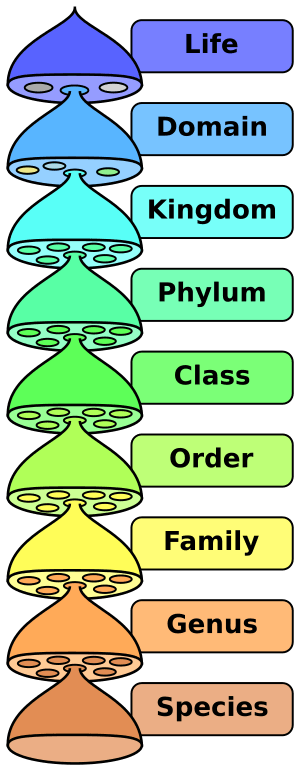Genus facts for kids
A genus is a special group used in biological classification, which is how scientists organize all living things. Think of it like a folder where you keep very similar items together. A genus sits above species (a specific type of animal or plant) and below families (a larger group).
A genus can have one or many different species that are closely related. For example, all types of true cats, like lions, tigers, and house cats, belong to the same family, but they are in different genera (plural of genus).
The word "genus" comes from Latin. The singular form is "genus," and the plural form is "genera."
When scientists write the official name of an organism, it always has two parts. The first part is the genus name, and it always starts with a capital letter. The second part is the species name. Both parts are always written in italic letters. For example, the scientific name for a wildcat is Felis silvestris. Here, Felis is the genus. Sometimes, there's a third word for a subspecies, like in Felis silvestris catus for a house cat, but this is less common.
What is a Genus?
A genus is a key step in the system scientists use to classify life on Earth. This system helps us understand how different living things are related to each other. It's like a big family tree for all animals, plants, fungi, and other organisms.
Imagine you have a group of very similar animals, like different kinds of bears. They might all be in the same genus because they share many common features. This helps scientists study them and understand their evolution.
Naming Living Things
The way we name living things using genus and species is called binomial nomenclature. This means "two-name naming." It was created by a scientist named Carl Linnaeus. This system makes sure that every living thing has a unique scientific name that is understood all over the world, no matter what language people speak.
For example, the genus Canis includes animals like wolves (Canis lupus), coyotes (Canis latrans), and domestic dogs (Canis familiaris). Even though they are different species, they are all part of the Canis genus because they are very closely related.
Genus in Everyday Language
Sometimes, the Latin genus name is changed a bit to become a common English word. For example, the genus Pseudomonas refers to a type of bacteria, and people might call them "pseudomonads."
However, for most common animals and plants, we already have simple names. Instead of saying "felids" for the cat family, we just say "cats." This includes everything from your pet cat to a wild lion, all belonging to the Felidae family.
Images for kids
See also
 In Spanish: Género (biología) para niños
In Spanish: Género (biología) para niños




